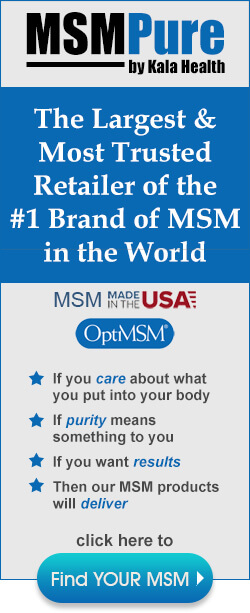History of MSM
MSM itself was first gradually identified around the time of World War II, by researchers studying the contents of cow’s milk. MSM is simply a particularly easy to absorb bioavailable form of sulfur, a geologically and biologically common mineral with central roles in many biological reactions. People have recognized sulfur for its healing qualities since ancient times, though we are today only barely beginning to understand how precisely sulfur contributes to our health.
Sulfur hot springs have been popular in both the old world and the new since long before recorded history, despite the rotting egg smell, and more than a few have been touted as a “fountains of youth” for their reported healing and age-defying qualities. Before the age of modern medicine, it was not uncommon for doctors to prescribe sulfur to patients with the instruction that it be poured into a hot bath to be soaked in. There is also a long tradition of using sulfur-rich plants, particularly, garlic, in ancient medicine. Cabbage, onions, horseradish, Brussels sprouts, leeks, mustard, and kale are all also foods that contain high numbers of organic sulfur compounds.
Though ancient humans long recognized sulfur for its healing qualities, it took modern science to rediscover and recognize the benefit of bioavailable sulfur. In the late 1950s, Dr. Stanley Jacob, head of transplantation research at the University of Oregon Medical School, encountered a sulfur compound known as dimethylsulfoxide-DMSO-while trying to find a way to freeze organic tissue without damaging it. While working with DMSO in the lab, he found that its medical use extended far beyond that of a cryoprotective agent. It showed analgesic and anti-inflammatory properties and promise as a skin-penetrating agent. Dr. Jacob hypothesized that DMSO would reduce pain when put over the location of an injury or localized bone or tissue illness.
He began testing it in his laboratory, and eventually started using it to successfully treat patients in his clinic who suffered from unresolved arthritis, bursitis, tendinitis, and other conditions. In 1963, he reported it to the meeting of the American College of Surgeons, and before long, DMSO was on the front page of The New York Times, touted as “the most exciting thing in medicine.” By 1965, over 1,500 studies had been done involving about 100,000 patients, primarily regarding its usefulness in treating musculoskeletal injuries and diseases.
Unfortunately, due to a medical catastrophe involving Thalidomide, a widely used sedative drug that had been discovered to cause serious deformities to the fetus when taken during pregnancy, the FDA overhauled its procedures and postponed its consideration of many interventions. One of the casualties of these changes was the approval of DMSO for medical uses, severely undercutting the source of the funding for all of the labs that had been researching it. It took five years to get DMSO approved for veterinary applications, where it became popular among veterinarians for treating a variety of musculoskeletal disorders in both large and small animals.
“MSM Pure flakes helped my dog with her arthritis pain.” – LightFoot on Amazon
Eight years after its approval for veterinary applications, and buoyed by its successful and safe use by veterinarians on animals, DMSO was finally approved by the FDA for extremely limited use in humans. Overseas, DMSO had already become widely used in about 125 countries, including Canada, the UK, Germany, and Switzerland. Popular support for expanding DMSO use in the United States remained strong, and in the State of Oregon, a special law was passed to allow the use of DMSO on humans beyond that which federal regulators had permitted.
Under the cover of this state law, Dr. Stanley Jacob, who, along with fellow researchers at the University of Oregon Medical School had continued his research of DMSO’s medical applications, was allowed to continue treating patients at his clinic, with continued success. In 1980, Mike Wallace of the CBS television show 60 Minutes decided to follow a California housewife named Sandy Sherrick as she sought DMSO treatment at Dr. Jacob’s clinic for sever chronic whiplash and nerve damage that she had sustained in a car crash two years earlier. Wallace and his camera crew followed Sandy Sherrick as she received several days of intravenous treatment with DMSO and visited her house months afterwards to learn that she was still pain free without medication, and that she had returned to her normal activities for the first time since her accident.
By this time, researchers had broken DMSO down into its components and had found that its major metabolite, DMSO2, was what provided its pain relieving and anti-inflammatory properties, along with other benefits. Dimethyl sulfone (DMSO2) is also known as methylsulfonylmethane, generally abbreviated to MSM. Dr. Jacob and his colleagues at the University of Oregon School of Medicine pursued their research of MSM and found that it was a highly promising molecule on its own, with the same benefits that had made DMSO popular, but without its unpleasant fishlike odor and taste, making it far more palatable for regular use. MSM was found to be incredibly safe, with an incredibly small instance of allergic reactions and a lethal dose.





